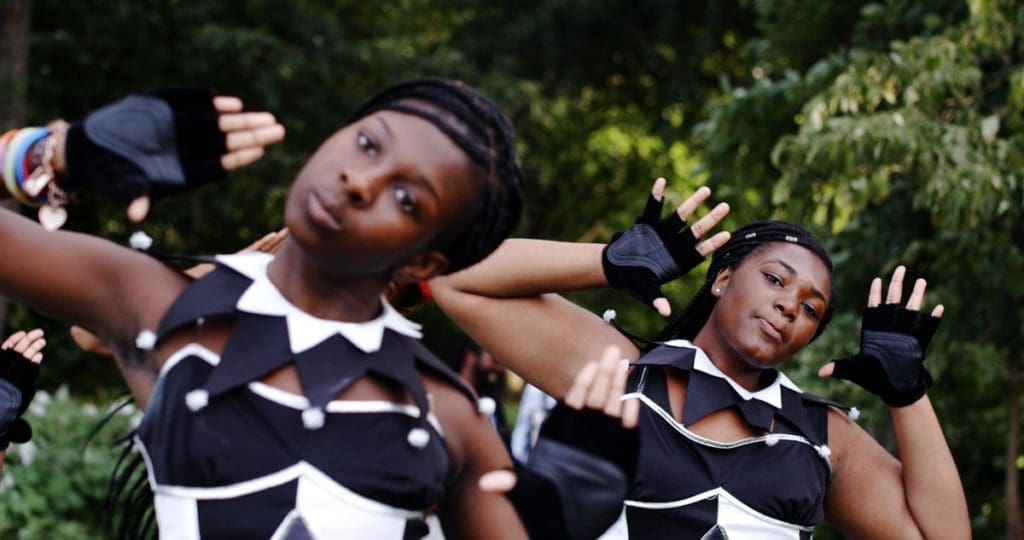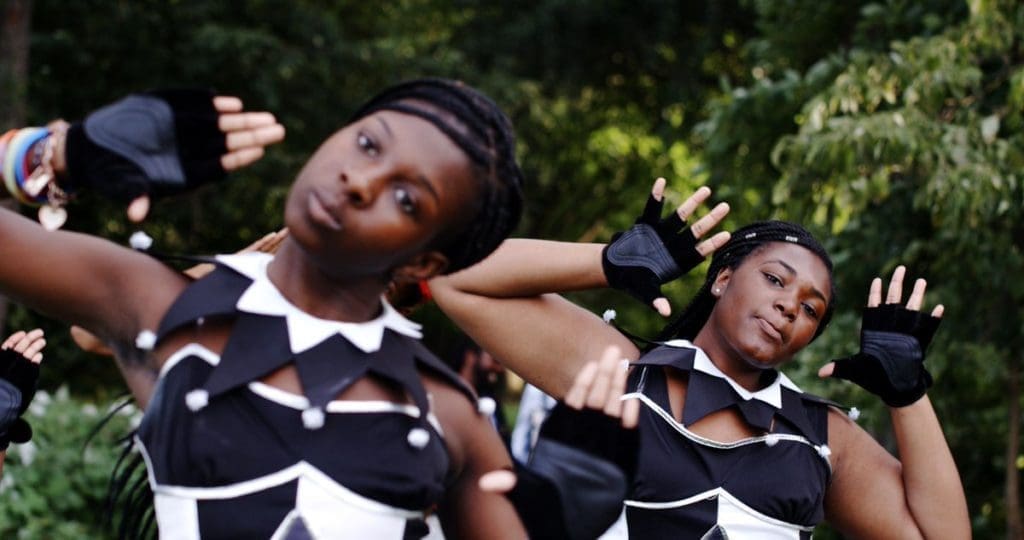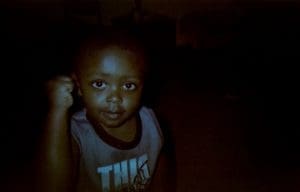BARETEETH bare love in the garden

In 2017 Bartram’s Garden was honored to welcome the artists collective BARETEETH on our grounds and in our community for an eight-month Southwest Roots Residency. On September 29th, they will be unveiling Been Here, a multi-channel installation that showcases Bartram Garden’s neighbors and friends as they perform everyday acts of art and movement. Been Here will highlight the creative power that has long existed in our community. The work features poetry by Sophia Poe, rhyme by Nyfease Sims, and the drumline Second To None. BARETEETH member, Althea Baird, took some time to speak to us about their process, work, and our community.

Still from BARETEETH’s video “Been Here”
Can you give me a brief history on BARETEETH?
BARETEETH is Jennifer Turnbull, Darlene DeVore, Althea Baird and Lily Hughes. For this project, we are also collaborating with mixed media artist Ash Richards, and film and sound artist Marie Alarcon. BARETEETH started in 2012 as a movement and dance theatre ensemble, just getting together, making things, and doing small performances in DIY venues like warehouses and community spaces. Collaboration has always been a huge part of our approach, usually with friends, family, and neighbors. We wrote a new artist statement for this residency:
“BARETEETH (BT) is an experimental dance collective that collaborates with artists from other disciplines to create time-based work and performances. Our current formation for the Southwest Roots Artist Catalyst residency includes BT dancers Althea Baird, Jennifer Turnbull, Darlene DeVore, and Lily Hughes, mixed media artist Ash Richards, and film and sound artist Marie Alarcon.”
Our work intersects along the theme of memory, both place-based and speculative. We look for the dance under the surface of the body, under the surface of the space, and trace its echo. We are interested in the entanglement of personal and collective histories, bearing witness to the impact of violence and making a space for healing as a never-ending journey. Our work explores the making of kin, the human and interspecies moments of care and intimacy that prefigure a world under or beyond racial capitalism and patriarchy.”
How did you get involved with Bartram’s Garden?
As a group, our first Bartram’s Garden project was a filming dance video here in 2014. It was a big ensemble piece with 50 dancers acting out this mass exodus away from the city and doing movements and singing a song that was passed down from our elders. In general, we live in Southwest Philly, everyone except Darlene, who moved from Southwest to Delaware when her kid wanted to go to school out there. We live here, our kids were born here, we’ve planted trees and watched them grow here, we’ve had friends live and die here. This is the environment we want to be interdependent with. It’s a troubled place to be as a group of transplants in an area that is gentrifying and being colonized. It’s still full of long-term residents—people who remember disinvestment, white flight, and watching the fireworks from the roof of the gypsum factory at Bartram’s Garden. We’ve all been hanging out at Bartram’s for almost 10 years, and because we live here we can do this work on the timeline of friendship, not just the timeline of a grant. Not that we are going to be able to stay friends with every person that we connect with at Bartram’s Garden, but that’s never how it works anyway. You stay friends with the people that you have need from and for, and that you have desire from and for.

Still from BARETEETH’s video “Been Here”
How did you reach out to the community in SW? How were you able to make the connection in order to build trust and collaborate?
We have spent a great amount of time with people in different settings including teaching dance classes at Bartram’s Village, volunteering at the Sankofa Farm (the neighborhood farm at Bartram’s Garden), participating in the community garden, and being nosey and just talking to people specifically at the playground, neighbor’s stoops, and the horse stables. We have also worked with the staff and students at Woodland Academy and some of our significant relationships were facilitated by Sophia Poe (the Southwest Roots Community Liaison), who already had relationships and connections in Southwest.

Photo by L. Turner
What projects transpired?
The first project we worked on was a tour of the garden for Bartram’s Garden staff. We re-presented and presented new information in the form of movement/dance, experiential guided direction, and reading aloud to them.
“We wove together the past, present, and future, and placed ourselves and the tour participants in that trajectory. We told and performed stories about workers and ghosts, displaced memories, Black joy and the future of the farm as a Black space, public housing, ecological resistance, and the plantation.”
The idea for the staff tour came when we were all mapping the stories, truths, intimacies of the narratives we were reading about and hearing from staff and neighbors. Our tour looked at the negative space on a map. We wove together the past, present, and future, and placed ourselves and the tour participants in that trajectory. We told and performed stories about workers and ghosts, displaced memories, Black joy and the future of the farm as a Black space, public housing, ecological resistance, and the plantation. Our intention was to guide participants through an experience such as a tour guide would, and to illuminate stories made and left in the gardens, especially those the garden doesn’t acknowledge. We incorporated movement, storytelling, and gifts like roses and mugwort tea in order to broaden the bodily and spiritual witnessing of the stories.
When we went on all the staff tours, we loved how the procession through the space was like a dance or a site-specific choreography. We picked up on this for our tour. We invited the staff to lie down under the Franklinia tree while they listened to a story about William Bartram’s rice plantation in Florida. We had them look through binoculars across the Lenni Lenape archeological site to see a dance performed on a pier on the other side. A lot of the pieces of the tour were building off information the staff had shared with us in the first place. We expanded on these pieces, both emotionally and historically, making them the center of the tour narrative instead of the margins.
The second project we did was a photography project where folks (a little over half were under 12 years old, the rest were over 25) that live or work near Bartram’s Gardens took photos on disposable cameras of places that are special or important to them in the area. This was a really helpful project for us to see what spaces people treasure, and beautiful to witness the amount of care and intimacy people feel towards the space, how well everyone knows it. At the photo exhibition people talked a lot about the peace and joy that the garden holds for them, and about seeing themselves and their friends and family in the photos also made them feel proud and loving, and like a sense of how much things change, especially kids growing up. At the exhibition, people spoke a little bit about their hopes and fears as they watch development take place, especially the plans to demolish Bartram Village and replace it with more expensive housing. There is talk about the new development being “mixed-income” but there’s no timeline of how long people will be displaced for, or how many folks will be able to come back, or any services being set up for the people being evicted.
We did a two-part workshop with a group of teenagers who worked this summer at the Sankofa Farm at Bartram’s Gardens. In the first part, they explored and wrote about their relationship with that land. In the second part, we traveled to a speculative future where the forces of capital have closed in on the space and they strategized about how to protect and defend it. The students created a small zine documenting the work.
Also, we did 10 weeks of dance classes for the cutest babies in the afterschool program at Bartram’s Village.
What can we expect to see at Been Here?
Expect to enter a dark room with four projection screens. Three of the screens are mostly dark, with slow light illuminating movements. This triptych is titled Been Here and it’s a multi-channel installation showcasing Bartram’s Garden’s neighbors and friends as they perform everyday acts of art and movement. On the fourth screen we’re showing an experimental documentary, about 30 min in duration, called, Witness, which is a contemplative collage of audio interviews and daylight activities that explore relationships between place and self. Been Here highlights the creative power that has long existed in these communities. Been Here features poetry by Sophia Poe, rhyme by Nyfease Sims, and the drumline Second To None.
What’s next for BARETEETH?
We have no clue!!!!


